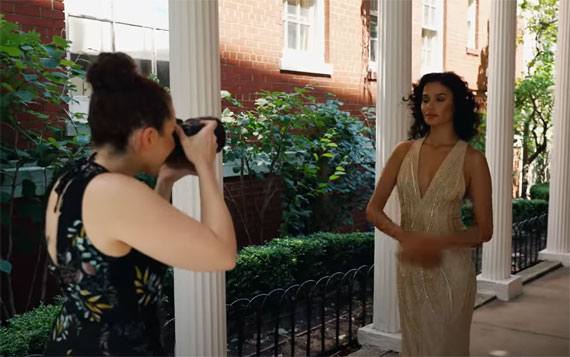Fashion shots are some of the most evocative — but usually get taken in a studio under controlled artificial lighting conditions. Many photographers fear stepping outdoors, including into the unpredictable weather and lighting conditions that go with it. At least, not without the help of a few friends — strobe lights, diffusers, and reflectors, in particular.
Fear no more! In this tutorial Lindsay Adler shares her foolproof tips and tricks on how to leverage natural lighting to your benefit.
Lindsay’s Outdoor Portrait Photography Gear:
- Canon R5 camera
- Canon RF 50mm 1.2 lens
- Canon RF 85mm 1.2 lens
Train Your Eye to Spot Natural Light
Natural light is all around. Training your eye to look for it, including the direction, tone, and brightness of it, is Lindsay’s number one tip. You could find it reflecting off nearby windows under a bit of overhang, like a porch or archway. Or bouncing off a nearby wall. The scenarios are endless.
One way to train yourself to become more natural light aware is to take test shots. Either with a friend or with the model. Though it may be tiresome for them on an official shoot, especially decked out in fancy clothing and elaborate make-up. Get your chosen model to face various different directions to identify the light sources present and which are most flattering.
Know The 3 Main Types of Light Sources & Scenarios
According to Lindsay, there are three main types of outdoor light sources and scenarios. Natural reflectors, covered shade, and slices of light.
The first type, natural reflectors, act very much like the reflectors you would bring with you on a shoot. White or bright-colored surfaces, such as a white wall, moving van, or window, for example. Except, these sources may be larger, making the light they reflect even broader and softer than that of a reflector.
The second type, covered shade, offers variable reflective light sources and scenarios, except not from above. As we know, direct sunlight from above can be the least flattering, causing dark shadows under the eyes and cheekbones. You’ll find more flattering covered shade lighting scenarios under a porch, covered passageway, archway, or the like.
…this is not something I would do for an everyday portrait. Instead, it’s something where I want something more sculptural or to play with highlight and shadow…
The final scenario, slices of light, offers a more dramatic effect, well-suited to fashion and artistic shots. Slices of light are usually highly-contrasted patches of light and shadow, such as dappling and close-quartered shady/direct sunlight spots. Use these slices to create exciting sculpted, dramatic, or abstract shots.
Leverage Multiple Types of Light Simultaneously
Usually, there will be more than one type of light present in any given outdoor scenario. Moving your model around and getting them to pose in such a way as to capture multiple lighting sources is ideal. First, identify where and how they’re most likely to “catch” these types of light.
Perhaps a soft, cool highlight directly from the blue sky. Or a more direct, bright, halo-like beam of the sun. Just like on the model Sam Swan’s hair in this video tutorial. Get your model to move into the various light sources. Then play around with complementary poses that capture multiple simultaneously.
Conclusion
Natural outdoor light certainly is unpredictable, but that doesn’t mean it’s impossible to work with. In fact, natural light can be as easy to harness and maximize as following Lindsay’s simple rules.
Like This Article?
Don't Miss The Next One!
Join over 100,000 photographers of all experience levels who receive our free photography tips and articles to stay current:






